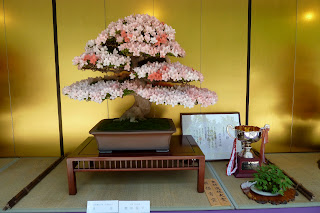Watching mottled carp dance and wrestle to the surface of the pond at Ueno Imperial Park, I realized I was watching an iconic Japanese scene: the carp among the lily pads and in the distance, an arch bridge leading to an impossibly old Shinto shrine. All this framed by a cloudless late-spring sky, a light, cool breeze, and my loud, rambunctious American children in clashing blue, orange and green baseball attire. With an early start, I was determined to march my family through all of the park, fighting off the lead-blanket of jet lag with relentless walking.
Only thirty minutes into the day, I was already seriously questioning my strategy. Moving along from the idyllic pond scene, reality began to sink in. The walking was fine, but the kids...oh dear God, the kids. The energy. The never-ending hunger. The pleas to go to the Pokémon store. How much vending machine ice cream would it take to get us through this day? Feeling a bit like Alice after she has finally stopped falling through the impossibly deep hole, I wondered: What do I do now? And like Alice, I quickly had my answer: with a rabbit-like pace and arms laden with shopping bags, a compact, dark-haired grandmother was making her way toward me. Rushing forward and speaking in what I could sense was extremely polite Japanese (though I could understand barely a word), she implored me to follow the path forward, pointing past the shrine in the distance. The few words I could make out were "ohana" (flower) and "kirei" (pretty). That's enough for me. I tried to assure her that we would do our best to make it that way and find the pretty flowers, but she seemed concerned that maybe I didn't understand how very important it was to her. She tugged at her iPad in one of her bags. Apparently, the flowers were important enough to warrant an iPad intervention. I thought that perhaps she was going to throw some Google Translator magic my way. But alas, she was gone as quickly as she had appeared, scurrying off in the opposite direction and leaving us to find our own way.
We made our way along the path, and Frank and I had a brief discussion; it seemed reasonable enough to us that there might be a flower exhibit somewhere in the vast expanse of the park. But it was 10 AM, and already time for the first ice cream vending machine stop. If our children were going to see flowers, there had to be ice cream involved. One ice cream stop, two shrines, and one baseball park later, we were significantly further along the path when once again, I found myself facing the same elderly Japanese woman. (Let's just call her Grandmother Rabbit おばあさんの兎).
Although Frank and I were shocked to see her again--not only because we did not expect to see her again, but also because she was approaching us in a rush from the same direction as before--Grandmother Rabbit seemed completely unsurprised and just as excited and emphatic as before. This time, she immediately reached into her bag and pulled out her iPad and began to reveal photos: Picture after picture of what looked to be azaleas pruned with bonsai-like care into glorious displays. Now, here is what you need to know: As a Native Texan, I take azeleas pretty seriously. In full bloom
against a lawn of green St. Augustine grass, Magnolia trees, and a few
East Texas pines, azeleas are an absolute festival of spring color.
Even in my NY yard, I coddle and fertilize my azeleas as though they
were the most temperamental roses. So, with a few more hand gestures and reassurances, I was able to convey that yes, I understood and we were definitely headed that way.
Not five minutes later, directly in front of the Grand Fountain, was the Japan Satsuki Association's exhibit of beautiful azelea bonsai. Grandmother Rabbit was gone, but she had definitely lead us to Wonderland:
*For more information on satsuki, look here (in Japanese): satsukikyokai.or.jp or here (in English, for the Azelea Society of America's page on satsuki ): http://azaleas.org/index.pl/satsuki.html
What you'll find on Storybook Days
The Home page displays all my musings on life in Japan and a few other things (baseball and children's books are distinct possibilities). For highlights only: "A Day in the Life (edited)." "Tabemono (Food)" is exactly that. "Big in Japan" is my completely biased and oversimplified list of what is popular in Japan, and "Kimono Count" is a day-by-day record of the people I see in traditional dress. "Editor's Delight" catalogs the unintentionally amusing and apparently quite complicated world of Japanese-English translation. "Uncle Tucker" tracks our sightings of a certain cat following us around Japan.



